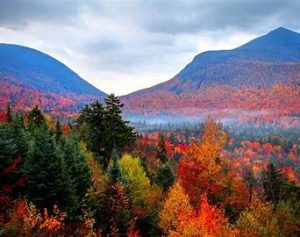This New England state is defined by its quaint towns and large expanses of  wilderness. In the north, White Mountain National Forest is known for winter sports areas and Mt. Washington, the region’s highest peak, with a cog railway to its summit. The White Mountains are home to the Appalachian Mountain Club’s High Huts, a delightful alpine experience complete with hot meals, and numerous ski resorts perfect for downhill skiing, snowboarding, cross-country skiing and snowshoeing enthusiasts. Also in the White Mountains are moose, black bears and part of the Appalachian Trail.
wilderness. In the north, White Mountain National Forest is known for winter sports areas and Mt. Washington, the region’s highest peak, with a cog railway to its summit. The White Mountains are home to the Appalachian Mountain Club’s High Huts, a delightful alpine experience complete with hot meals, and numerous ski resorts perfect for downhill skiing, snowboarding, cross-country skiing and snowshoeing enthusiasts. Also in the White Mountains are moose, black bears and part of the Appalachian Trail.
The state was named after the southern English county of Hampshire, England, by Captain John Mason. Granite is the traditional rock in New Hampshire. Back in 1830, New Hampshire was known as the Granite State, and this nickname has prevailed to the present day (there was once a huge industry based on the quarrying of granite).
The coastal city of Portsmouth has a vibrant culture of dining and history, including the Strawbery Banke Museum, a living history museum great for the whole family. Take a Brewery Tour to see the sights and sample some local beer. And, of course, your accommodations will be as impressive as the surroundings; stay in some of the world’s most renowned historic hotels, including the Omni Mount Washington Resort & Hotel.
Every year, visitors and locals return to the mountains in New Hampshire to keep their winter ski and snowboard traditions alive. With 19 ski areas around the state, there’s fun to be had for every level and ability. New Hampshire is also home to one of the most extensive networks of cross-country ski trails in the East. Be sure to make a trip to the lodge after the day is through for après ski treats. Take a romantic sleigh ride for two, or pile the whole gang into a 20-passenger logging sled.

If you can walk, you can snowshoe. It’s really just about mastering the nuances of walking with a pair of large, clunky shoes strapped to your feet. But those large, clunky shoes allow you to maneuver gracefully through challenging wintry landscapes, up rolling hills draped in snow and along icy paths with ease. But if you’re new to the sport, be sure to check out REI’s Beginner’s Guide to Snowshoeing for great tips on honing your skills. As far as equipment—the most you’ll need is the snowshoes themselves and an optional pair of extendable poles. And the cherry on top is that you can rent snowshoes from outfitters, inns, and trail networks all across the state with groomed tracks right on site. So all you really need to bring is a warm winter coat, a pair of comfortable winter boots, and some good snow pants!
 Extended Weekend Getaways
Extended Weekend Getaways